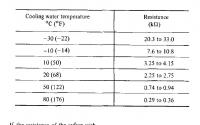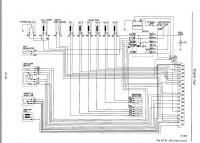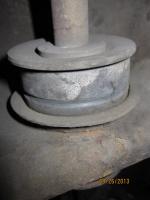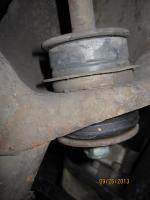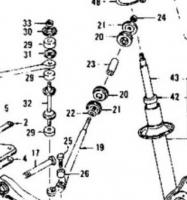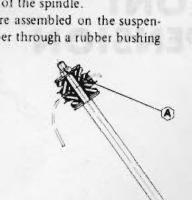Everything posted by Zed Head
-
starter interchange/repair
The Nissan Factory engineers knew how and they even wrote instructions and drew pictures for people servicing their own cars. It will take some manual effort though. Good luck. Hint - it's an electrical component. Index of /FSM
-
Brake conversion upgrade!
Search "brakes" - Welcome To Motorsport & The Z Store! Nissan-Datsun 240Z-260Z-280Z-280ZX-300ZX(Z31/Z32)-350Z-370Z Parts! or just go here - Silver Mine Motors
-
rear suspension question
Did you install aftermarket urethane bushings or factory rubber? The reason that you tighten the factory rubber with a load on the wheels is because the rubber does not slide or rotate against the metal bracket very much, most of the suspension movement is taken up within the rubber itself. So the point of tightening with the wheels loaded is so that the rubber is not "loaded" or strained most of the time, only when the suspension moves. The round urethane replacement bushings, on the other hand, rotate within the brackets when the suspension moves (typically causing noise, that's why grease is recommended). So they can be tightened at any time. They're just going to rotate in the bracket anyway. That's my interpretation of the bushings options. I could be wrong.
-
Timing Chain Install with Pics
The timing chain always has some slack in it. There's a slack side and a tight side. You need to follow the procedure in the FMS for determining timing chain wear. Put the timing mark on zero and see how the notch in the camshaft sprocket aligns with the groove in the retaining plate. It's outlined in detail, with drawings, in the Engine Mechanical chapter. The backfiring and weird running could have several causes, from lean mixture to ignition timing. What year car and engine?
-
Cleaning maf 78 280z
When was the last time it ran before you got it? Have you changed the air filter and checked the air inlet for mice nests or other clogs? When you're driving it, does the engine pop and backfire or does it smell like too much gas?
-
Looking to make a "square" L24 with LD28 crank...
I probably came across as negative in my post. Just trying to save you some money. The two sentences above shout "thousands of dollars" just to get to the end of the second sentence. Seriously, all of the hydraulics are probably bad, there's probably body/frame rust, the engine may need one or two thousand if you rebuild it along with the carburetors, and on and on. A broken stud or bolt here, a cracked thermostat housing there, the nickels and dimes just start rolling. Wait until you have the car in your possession and know what you have. If it's a very early Z you might decide to just restore it, or pull the numbers-matching motor (if it is) for safe keeping.
-
Looking to make a "square" L24 with LD28 crank...
I almost replied to this thread yesterday about the "square" concept, but decided to just leave you to your eccentricity. It's hard to tell if you're really trying to be sensible or just want to put an odd collection of parts together. Sticking with the original engine because it looks original, but modifying it so that it's not original doesn't seem to serve any purpose. The "square" bore-stroke ratio has no technical merits at all, it's just a weird number thing. Porting the stock head and installing bigger valves is what used to be done before the 280Z heads became available. And the most effective way to get more displacement is to get an L28. The money that you're proposing to spend on the LD28 "knife-edged" crank would be more useful elsewhere. Overall, once you do the math on collecting those parts, installing bigger valves, porting the head, buying custom pistons (I don't think that there's a stock set that will work), knife-edging the crank, etc. I think that your bank will be seriously damaged, if not broken. Do the math, then send the engine to Rebello and ask him to give you as much power as possible. You'll be many dollars ahead AND the engine will probably run well and not self-destruct, plus you'll have the Rebello "cool" factor on your numbers-matching engine. As far as learning goes, you're at about 1980, I think,with the big-valve, high compression stroker engine. No offense, you seem to be learning, probably from various old internet postings, but what you've proposed won't be cheap, probably won't run as designed unless you use expensive race gas, could very well blow up quickly, and won't be tunable by the average mechanic. Full disclosure - I'm only speaking from what little I've learned over the past few years. Not an engine builder, so I could be way off base.
-
Brake pads
I'm curious about the Wagner Ceramics also. I went through a whole search for pads thing, using all internet info, and it came down to the Wagners or Centric Posi-Quiet Ceramic pads. I chose the Centric pads but haven't installed them yet. I have Beck Arnley pads on now and they work well but they took some extra effort with the factory shims and anti-squeal spray to get them not to squeal. One pad still squeals when braking backward. One reason I went with Centric was that they seemed to have a good anti-squeal considerations,with shims pre-attached, and they say that they're "scorched" at the factory for minimum break-in time. Who knows...
-
Alternator upgrade ?
That is not uncommon. Cleaning all of your electrical connections will probably help. Fusible links, fuses, etc. The problem isn't the max capability of the alternator but the output at idle. They are somewhat related but not directly and not consistently from what I've found. I had a parts store alternator that had poor output at idle, while an old factory unit barely noticed the loads at idle. Might be worthwhile to just get a new alternator and/or clean all of your electrical connections first. Check to see if you have a 50 amp or 60 amp alternator first. That might be the easiest upgrade for you. Apparently the 260Z used either a 50 or a 60 amp alternator from the factory. LT150-10 or LT160-23 (numbers from the FSM). There aren't many easy upgrades, if you're already at the 60 amp standard that was used through 1983, unless you spend some money.
-
Runs Nice for a Few Min. Then Rough, Then Kills...
Sorry Len, but that is not how the vacuum adjusted fuel pressure regulators (FPR's) used on the L-Jetronic system work. The hose that runs from the FPR to the intake manifold adjusts pressure to the FPR's internal diaphragm as manifold pressure drops (intake vacuum). So at high intake vacuum (low intake pressure) conditions the fuel pressure in the rail will drop. Typically to the 27 - 30 psi range. When the throttle is opened and manifold vacuum matches outside conditions, the pressure will then rise to ~36 psi. Some of the older Jetronic systems (D-Jet maybe) apparently ran a constant pressure regulator with no vacuum adjustment. Maybe you're thinking of those systems.
-
compression readings
Blue smoke might be an overly rich mixture. Goosing the throttle is when extra gas gets added. Are you running the stock EFI? Run through the cloud of fumes and smell it. Oil burning smells different than the gasoline of a rich mixture. And I think break-in time varies depending on the rings used. Chrome rings are noted to take a long time to seat, for example.
-
compression readings
What are you trying to figure out? Who rebuilt the engine, professionals or home garage mechanics? What parts did you use? Were the cylinders honed to match the type of ring used? How badly does it smoke? Sounds like you're new engine is smoking badly and you're wondering what happened. But you're not giving any details for anyone to offer advice.
-
compression readings
If you're looking for a ball park number, they look like what I just got on my N47/N42 engine, 172-175 across all six. The high numbers anyway. Just tested it about a week ago, trying to diagnose a noise. I drive it daily and it has many miles on it, but it runs very well. It sat for ten years before I got it also. Your low numbers would be for all of the reasons you mentioned, dry, cold, unseated rings in a slowly spinning engine (one plug at a time). Or because your valves need adjustment. Or both. Otherwise, it looks like it's ready to start, break-in and go driving.
-
Uhm. I think thats supposed to be attached.
In case anybody wants to find that AC Delco bushing kit, Rock Auto has it listed as a Shock Absorber Bushing for some reason, not Strut Rod Bushing. Came across it by accident. Here's the part number if CO hasn't already posted it. The number alone will work in Parts Search. Part # 45G25036 (Edit - actually you can see it on the box in his pictures...)
-
280z cranks, but will not stay running.
Pretty sure that some test lights don't need 12 volts to light. So you might be in the range of the ECU voltage, whatever it is, probably in the 5 volt vicinity. You should still measure resistance from the ECU connector. The pin numbers are in the drawing I attached. The method for moving the AFM vane is okay, but the injectors still shouldn't click. Maybe what you heard was the fuel pump relay clicking, under the dash by the hood release handle. If the injectors are clicking when you move the AFM vane you should figure out why. They shouldn't be doing that. I don't know what you mean by "electronically controlled idle control". Good luck with that. And in your first post you said the engine dies immediately, now you say it runs for a minute, so not too clear on what's really happening. Since you're running a different intake manifold and throttle body, make sure the BCDD (if the W48 has one) and the EGR system aren't leaking.
-
280z cranks, but will not stay running.
These two things seem odd. The first is just wrong, the AFM vane opening should not make the injectors click. If the injectors are clicking when you open the AFM vane something weird is going on with your wiring. I don't know where 77Datz ever read that that was normal. It's not. And the second thing is odd since there is no FSM test for power at the coolant temperature sensor, although it may get power from the ECU when the key is On. I don't know why anyone would do that test, the test is to measure resistance from the ECU connector. What was the voltage reading and how did you measure it? So, the AFM causing the injectors to click is odd. But, the main reason for the engine to start the die immediately, is because the fuel pump contact switch is not being made in the AFM. You can test that also with an ohm-meter by measuring resistance at those two pins at the ECU connector and moving the AFM vane.
-
Runs Nice for a Few Min. Then Rough, Then Kills...
Fuel pressure should be ~30 psi when idling, and 36 psi if you test without the engine running, but with power to the fuel pump. 10 - 20 psi is way too low. You may have other problems, and it may run rich if you fix the fuel pressure but it sounds like the engine might be getting by on low pressure when cold because the ECU adds fuel when cold. When the engine warms up the low fuel pressure makes the mixture too lean. Popping through the intake is a typical sign of that. Clogged fuel lines and inlet screen in the gas tank are common 280Z problems. It's also possible that the new filter is already clogged with rust from the tank. Read the Engine Fuel chapter for a good description of how things should work. Index of /FSM/280z
-
HELP: Need original lower front valance, grill
Just saw this - 240z valance pieces (all 3 ) - Nissan : Datsun ZCar forum :Nissan Z Forum: 240Z to 370Z
-
Headlight relay options
There are two switches that tend to heat up and/or have problems on the headlight circuit - the combination switch before the headlights and the dimmer switch after the headlights. You can put a relay in front of the combination power switch pretty easily to take the load off of it and leave the dimmer switch alone. One option, fairly easy because the power supply line is accessible by the fuse box, and there's room to hang a relay. The dimmer switch is more complicated because there are a high and low beam circuit to tap in to and the wires aren't as accessible. I think that the MSA/Irwin kit does both, maybe running lights too. Putting a relay on the running lights is fairly easy also, but not as easy as the headlight power switch, because you can tap in to the line before the combination switch. Harder to find a place with room to tap in and hang the relay. I've done the headlight and running light switches on my 280Z, but not the dimmer. The dimmer gets dirty but it doesn't seem to heat up like the power switch. Just adding some alternate views. If you don't like cutting wires and crimping or soldering, the plug-and-play is the way to go.
-
How much does an E31 head weigh?
Maybe they upgraded the bolts or tried to fix recurring problems, but 1972 has 2 turns ending at 54.2 ft-lbs, 74 has 3 turns ending at 61 high end, and 78 just shows 51-61, no turns.
-
HELP: Need original lower front valance, grill
The one that you said you wanted is the stock later model S30, big body 280Z style. Do you have a late or early 260Z? I think that you'll have to hit the wrecking yards for that piece, or those pieces. There are three pieces - the middle section and the two ends that attach to the fenders. The middle section is typically jacked-up from skimming parking curbs or bushes, it's hard to find a good one. The "or maybe" valance is on an early body and looks kind of like the MSA unit. Motorsport! Fiberglass Air Dam, With License Recess & Ducts, 70-8/74 240Z-260Z - The Z Store! Nissan-Datsun 240Z-260Z-280Z-280ZX-300ZX(Z31/Z32)-350Z-370Z Parts
-
Do i need to reset timing when installing a replacement head?
Jeff G knows more than I do about this stuff and raises some good points. In addition, you, the OP, didn't say if you were getting a complete head with the camshaft still installed or a bare head, or a head with vlaves and springs but no camshaft/rockers. If you're swapping cam and rockers, there are more things to consider. Lots of knowledge on the forum, describe what the salvage yard is sending you. Also, I overlooked that you have already removed and replaced the original head. It should be the same process, if notch and groove are lined up.
-
Do i need to reset timing when installing a replacement head?
If you set your timing mark to zero on the compression stroke and the cam sprocket notch is lined up with the oblong groove as shown the Engine Mechanical chapter, BEFORE you take everything apart, you should be able to align the notch with the groove on the replacement head before you install it and everything should drop in to place and be correct. Those are the two pairs of things that need to match - damper pulley notch with zero, and oblong groove with sprocket notch. Get everything aligned and the chain in place before removing the chain tensioner holding block, and don't turn anything until those are aligned.
-
Uhm. I think thats supposed to be attached.
1976 has a "tin cup" attached to the frame to support the bushing. Looks like yours doesn't have it, in the first picture. Attached a picture. As I said, I'm not familiar with 73. If you find it and it's supposed to be there, it may not need to be attached, you could just take the rod out and re-insert it. Also, you do know that the easiest way to remove and replace the rod is with the suspension loaded? Mentioned in case you fought it with the wheel in the air.
-
Uhm. I think thats supposed to be attached.
I spent some time trying to figure out which way to install those bushings also. I've attached a copy of the drawings from carpartsmanual.com and the FSM that seems to show them with the smaller diameter pointed away from the body. Like your "wrong" picture CO. But, I just checked mine to see what I ended up doing and find that I installed them with the big,thick part away from the center. I remember examining several TC rods that I had acquired and they seemed to be installed that way. I vaguely recall then rationalizing that with PU in the front, there would be less stress on the rod end with the small end in the cup. I'm going to leave them that way since I'm already non-factory with the urethane. Nobody has really addressed the other odd thing about the OP's issue though - what is the brass-colored metal piece attached to the bushing in his first picture? Did somebody add a washer? I've not seen a piece like that that fits in to the bushing cup. If there was one on the other side that would have created about 3/4" of steel that the rod would have been fighting against during use. Blue's first comment might be the main reason it broke. Edit - I think that metal piece might actually be the factory cup that was welded or brazed to the frame. Maybe. I don't know what they were doing in 1973. Hopefully not, but if so, it should probably be fixed.




